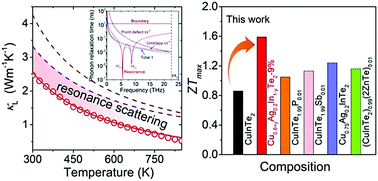Ultralow thermal conductivity in diamondoid lattices: high thermoelectric performance in chalcopyrite Cu0.8+yAg0.2In1−yTe2†
Abstract
Because of its unique transport properties, CuInTe2 has been considered as a promising p-type material for thermoelectric applications. However, its diamondoid structure gives it a high intrinsic lattice thermal conductivity that greatly limits its thermoelectric performance. In this study, we demonstrate that Ag alloying gives rise to an extremely low lattice thermal conductivity of 0.47 W m−1 K−1 for Cu0.8Ag0.2InTe2 at 850 K. Moreover, we found Cu doping significantly improves the carrier mobility while simultaneously increasing the carrier concentration. As a result, the power factor of Cu0.8Ag0.2InTe2 increases and a maximum ZT of ∼1.6 is achieved at 850 K. Both DFT calculations and low temperature heat capacity measurements suggest a strong interaction between low frequency optical phonons and heat carrying acoustic phonons, which is derived from the weak Ag–Te bonding. This strong phonon coupling decreases the Debye temperature and induces a low sound velocity.



 Please wait while we load your content...
Please wait while we load your content...